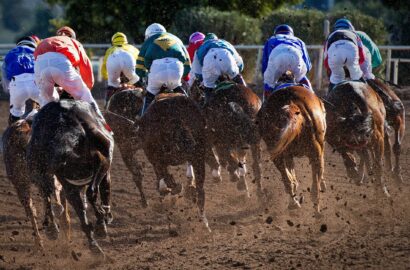
 Horse Racing Betting Tips & News
Horse Racing Betting Tips & News
The flat racing season is gearing up, and if you’re ready to pay a visit to the parade ring and are looking for tips for betting on flat races then you have come to the right place. Flat racing is the purest form of horse racing, it’s fast, tactical, and exhilarating. Betting on it can be just as hair-rising, but only when you know what you’re doing. Whether you’re an experienced pony punter or just finding your feet, our guide will help you back more winners and avoid finishing dead last.
What Is Flat Horse Racing?
Flat horse racing is exactly what it sounds like, no jumps, just pure speed and stamina. As the name suggests, races take place on level ground and vary in distance, from short sprints to longer, intensive tests of endurance. The flat season in the UK typically runs from late March to early November, with world-renowned meets like Royal Ascot and Glorious Goodwood drawing eager crowds and top-class competitors.
Here Are Our Tips For Betting On Flat Races
1. Ground Conditions
The state of the track also referred to as the “going”, can be a deciding factor in how a horse will perform. Some horses thrive on firm ground, where the conditions are dry and tough, while others prefer a softer surface where there’s some give underfoot. Checking the going report before you place your bets can give you a crucial edge.
2. Form
A horse’s recent form is one of the best indicators of future success. Study their last few races: Are they improving? Consistent? Struggling? A horse in good form is more likely to stay competitive. Typically, you can find the horse’s form on the betting slip, and it’s indicated by a sequence of numbers just below the horse’s name, which represents the horse’s most recent finishing places.
3. Trainers and Jockeys
A top-class horse needs a skilled trainer and a savvy jockey. Look for successful trainer-jockey partnerships, they often have a winning formula. Looking at the meet, which trainer has had the most winners recently can sometimes be a good indication of where trainers take what races seriously.
4. Horse Size and Weight
Lighter horses may have the edge in speed, but bigger horses can sometimes outstay their rivals over longer distances. Also, be sure to check the weight the horse is carrying, this can impact their performance, especially in handicap races. Compare horses and how their weight can affect the ground they run on, if the ground is soft, will a heavier horse struggle? The weight of the jockey can cause further implications, a heavy horse with a jockey that’s heavier than its rivals means the horse needs to work harder to pull the weight.
5. Breed and Pedigree: Born to Run
Some breeds excel on the flat more than others. Horses with strong bloodlines often have a natural advantage in speed and stamina. A thoroughbred with a genetic history of record-breaking running on the flat is a likely front-runner for your betting slip. Comparing these horses with new entrants or first-generation racers can provide valuable insight. The odds are likely in favour of those who have horse racing built into their DNA and are able to cope with the physical demands of the racing world.
Understanding Racecards and Odds
Racecards are your cheat sheet for every race. They show each horse’s name, age, weight, form, and the jockey’s silks. Understanding these details helps you spot the most promising runners.
Odds reflect a horse’s perceived chances of winning, but the favourite doesn’t always come out on top. Sometimes, the real value lies in backing an overlooked contender. That’s why it’s crucial to take into account each statistic given to the racers.
When Does the Flat Racing Season Start and End?
The UK flat racing season kicks off in late March and wraps up in early November, with major events like the 1000 and 2000 Guineas, Royal Ascot, and the Ebor Festival marking the calendar. Traditionally, the Lincoln Handicap in Doncaster held in March signifies the start of the season, wrapping up with the November Handicap on the same course. However, flat racing continues all year round on all-weather (AW) tracks, meaning there’s no seasonal limit to perfecting your betting strategy and getting to know the horse racing industry favourites.
What Is a Handicap in Flat Horse Racing?
In a handicap race, horses carry different weights based on their ability with the goal being to level the playing field. Picking a winner in a handicap often requires a bit more research and intuition. Handicap races are so closely contested that they create incredibly competitive betting markets with each horse having a supposed equal chance at victory. It provides a great test for your betting strategies, the outcome of each race depicts whether each horse will move up or down the rankings, making them important races to be aware of to track a horse’s racing career.
Ready to Back a Winner?
Flat racing is a thrilling ride, and with the right knowledge, your bets can go the distance. If you’re hungry for more tips for betting on flat races then check out our other horse racing articles or head over to the Tangobet site to place your bets.
Good luck, and may your picks always find the winning post!
Related articles


Is Royal Ascot Good to Bet On?



